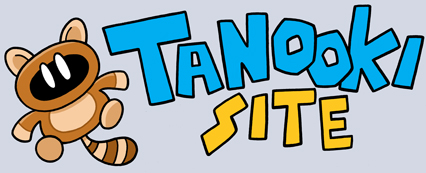Japanese Things in Video Games
The Japanese are very into this idea that most things in life have an objectively ideal or “correct” form. They even have a word, kata (型), which, although difficult to precisely translate, basically means “the proper form of something,” be it the beauty of a geisha, the structure of a tea ceremony, or even something much more trivial, like the design of a pencil. This idea of kata, coupled with the generally conformist nature of Japanese society, goes a long way to explaining why many objects and props found in Japanese-made video games look so visually consistent across titles, genres, parties, and platforms.
What follows is a bunch of drawings I made of the objectively “correct” version of how certain things should look, according to the broad Japanese cultural consensus. If you’ve played a lot of games, they’ll probably look familiar.
But first, a word about Japanese.
The Japanese language has a total of three alphabets, and the names of most nouns are written either in kanji if the object is something the Japanese have known about for a long time, or katakana if the object is foreign or made-up. The kanji alphabet usually describes something with one or two very detailed hieroglyphic characters, while the katakana alphabet, which is sound-based, uses a string of simplistic characters to spell out a word phonetically. (The third alphabet, hiragana, is used mostly for grammatical stuff.)
Now, the Japanese are fond of phonetically translating English words into Japanese via katakana, but the weird complication is that the Japanese also have a pronounced tendency to call things by English names they think are correct, but really aren’t. In America, we would call this Engrish, but the Japanese call it wasei-eigo (和製英語), or “made-in-Japan English.”
For example, the wasei-eigo word for “popsicle” is “ice candy,” which then becomes “アイスキャンデ” in katakana, which sounds like “ai-su-ki-yan-de” when spoken out loud, due to the phonetic limitations of the Japanese alphabet. And good luck expecting an American to know what you’re talking about when you ask for some “ai-su-ki-yan-de” on a hot August afternoon.
Anyway, when identifying names on this page, I’ve always tried to note both the katakana spelling and the weird “Engrish” name it’s trying to translate, if one exists.
Fruit
Fruit (果物) in Japan is so absurdly expensive that it’s often elevated to the status of a luxury good, which explains why it often appears as a thing you collect for points in arcade games. Around Christmastime, it’s not uncommon to see a fruit gift box (果物の箱詰め) of a single ripe orange, apple, peach, pineapple, and cantaloupe going for more than 100 bucks. These high prices are either the result of the legitimate costs of importing foreign produce or price-fixing mafia cartels, depending on who you ask.
 | Unsurprisingly, the Japanese always depict apples (リンゴ) as Fuji apples, with a two-tone skin of red and yellow. Their apples tend to be quite a bit larger than what westerners would consider normal, too. |
 | Cantaloupe melons are the most expensive of all of Japan's overpriced fruit, often selling for $40 US or more — hence why they're often the highest point item in any game that uses fruits as prizes (for the true premium experience, try a Yubari cantaloupe [夕張メロン], they can go for as much as $100 each!). For some reason, the Japanese always leave a "T" shaped portion of the stem on their cantaloupe, which can cause confusion among westerners (the cantaloupe prize in the original Pac Man, for instance, was long assumed to be either a badly-drawn pineapple or grenade). It should likewise be noted that the Japanese simply call cantaloupe "melons" (メロン) as if it's the default version of the entire fruit family. "Melon"-flavored things are very common in Japan. |
 | Peaches (桃) are always depicted in this implausible upside-down pose. |
 | Persimmons (柿) are a considerably more mainstream fruit over there than they are in the West, and are often included in conventional depictions of the "major fruits" along with bananas, pineapples, etc. |
Vegetables
Like us, the Japanese differentiate fruits from vegetables (野菜), but the way they sort the two is not always the same. Japanese people generally consider watermelons a vegetable, for instance, along with nuts and roots.
 | Mushrooms (茸) always have brown caps and tan bodies. |
 | Sweet potatoes (甘薯) are grown in many parts of Japan and usually have red-purple skins and dry yellow flesh. They're very much associated with the fall harvest season, in the same way Americans might associate pumpkins or squash. |
 | Roasted chestnuts (栗) are a popular, traditional Japanese snack, which has helped popularize them as a popular, traditional Japanese vegetable. |
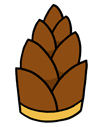 | The soft flesh of bamboo shoots (筍) is a common ingredient in Japanese cooking, making the bamboo shoot another "staple" vegetable in the Japanese cultural canon. |
 | Japanese kids supposedly hate eggplant (茄子) with a burning passion, so the vegetable is kind of a generic symbol of a gross food, in much the same way broccoli or Brussels sprouts are in America. Interestingly, the Japanese usually learn the British term "aubergine" as the plant's English name. |
Western Foods
Just as we in the West might not be particularly well-versed in the diversity of styles and flavors of, say, teriyaki chicken, the Japanese are generally only aware of certain very specific versions of common western foods.
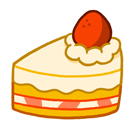 | Cake (ケーキ) in Japan is considered a real western delicacy, and much care and effort goes into their baking and decoration. What most Japanese would recognize as a western-style cake is actually more similar to what we'd call a strawberry shortcake, with an airy, foamy base and light whipped cream topping. These are particularly popular at the ridiculously consumerist spectacle that is Japanese Christmas, where beautiful strawberry shortcakes are as much a clichéd icon of the holiday as Christmas trees or Santa Claus. |
 | An even more bizarre premise is the large role fried chicken (フライドチキン) plays in Japanese Christmas — the result, apparently, of a brazenly deceptive KFC campaign in the 1970s that simply lied to the Japanese and told them buying fried chicken at Christmastime was a proud western tradition. Because of the association with the holiday, fried chicken legs are often shown decorated with festive ribbons. |
 | This is a dish known as "Omurice," (オムライス) a typically Japanese portmanteau of "omelette" and "rice." It consists of a thin layer of scrambled egg over a lump of cooked white rice. The shape is always neat and oval, and there is always a glop of ketchup exactly in the middle. |
 | Japanese curry (カレー), though the Japanese are under the impression this is some foreign dish. In contrast to traditional Indian curry, the Japanese variety is thicker, saltier, and almost always made of beef, making it much closer to a sort of tangy, gravy-like stew. It is always served (and depicted) poured over exactly one half of a shallow plate of white rice. |
 | The correct color for Popsicles, called simply "ice candy" (アイスキャンデ) in Japanese, is blue, based on the most common flavor. If the flavor is given a name, it's usually called "soda" and tastes more or less like the drink Americans know as cream soda. |
 | On a related note, the standard depiction of "soda" (ソーダ) is always blue as well, despite the fact that Japan is actually home to all the major soft drink flavors of the United States. |
 | What we call a snow cone, the Japanese often incorrectly translate as frappe (フラッペ), but they do have their own word, kakigoori (かき氷), as well. They come in many different "tastes," as the Japanese would say, but the cherry or "blue Hawaii" flavors are the most commonly depicted. They're almost always shown served in little cups with the Japanese character for "ice" (氷). |
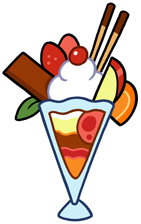 | A sundae is usually called a parfait (パフェ) in Japanese, one of those occasional instances in which a French word has entered the Japanese vernacular. A "correct" Japanese parfait is always served in a tall sundae cup with many fancy, elaborately prepared fixings, such as cookie sticks and fruit slices sticking out of the top. |
 | Western-style cookies (クッキー) are usually only depicted in a couple of very fancy varieties, as the Japanese associate them more closely with the stereotypical upscale British culture of "tea and biscuits" than fun things for little kids to eat. If you've played the multi-platform puzzle game Yoshi's Cookie (1992), you'll probably recognize some of these common depictions, which typically include black-and-white checkers, jam centers, rings, and macaroons. |
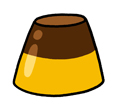 | What the Japanese call "pudding" (プリン) is always depicted as the dish we would recognize as a caramel flan, with a yellow base and burnt caramel top. |
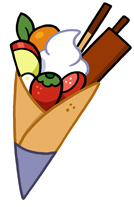 | Crepes (クレープ) are another "western style" dessert treat that are probably more common in Japan than the actual West. They're always folded into a perfect triangular cone, and like parfaits, will have a variety of delicious decorative flourishes poking out of the top. |
 | The beleaguered housewives of Japan put a lot of effort into making their kids' lunches a bag of laughs. One common gimmick is to cut their hot dogs into little octopus-looking things, a treat known simply as "Octopus wiener" (蛸 ウインナー). |
Japanese Foods
Japanese food, which the Japanese call nihonshoku (日本食, literally “Japanese food”), is obviously an enormous category encompassing an almost impossibly large array of unique courses, meals, treats, and snacks. But that doesn’t mean certain foods aren’t more common or popular than others. The list below depicts some of the Japanese foods the Japanese themselves usually depict with steady frequency in their media.
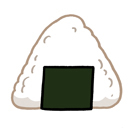 | These are known as Onigiri (御握り), a name that's often translated into the pointlessly literal "rice ball" in English media. Cold, triangular, seaweed-wtapped balls of cooked rice with a small glob of shredded meat or fish buried in the center. The standard depiction will have the seaweed arranged in a small strip at the base of the triangle (for holding) even though you don't see many Onigiri actually prepared that way these days. If the center filling is depicted, it will be a red umeboshi pickled plum, one of the more disgusting, cheap flavors. In Japanese culture, Onigiri are often used as a generic symbol for "food," much as we in America may use a hot dog or hamburger. |
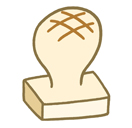 | The Japanese are very fond of this sticky, doughy, goopy substance known as mochi (餅), made of mushed up rice. When cooked in thick squares on the barbecue, it tends to bubble up in a comical fashion that's often ridiculously caricatured in Japanese cartoons. |
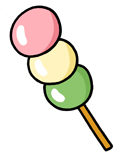 | Another form of mochi, this kebab is known as a sanshoku dango (三色団子) and consists of three mochi balls on a stick, each dyed a different fun color (which is to say, pink, white, and green, in that order). If you're expecting three fun tastes, prepare for disappointment. |
 | Manju (饅頭) is a small dough ball filled with meat or bean paste. This one is known as an onsen manju (温泉饅頭), and is a special bean-filled treat associated with visits to the sauna. It features the genetic Japanese symbol for "bath house" printed upon it. |
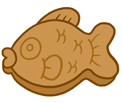 | Taiyaki (鯛焼) is another form of wagashi (和菓子), or traditional Japanese dessert. It consists of dough in the shape of a tai, or Japanese snapper (see below), filled with red bean paste. Truth be told, most wagashi are just various things filled with red bean paste. |
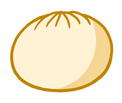 | These are known as nikuman (肉饅), literally, "meat bun," and the Japanese consider them a Chinese food. They're a very common snack just the same. |
 | A Japanese rice cracker or senbei (煎餅). Almost always depicted with a black square of seaweed on top, which is one of the most popular flavors. |
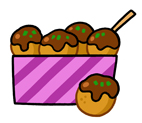 | Little batter-covered octopus balls known as takoyaki (蛸焼). Since a lot of Japanese folks will eat these things while hanging out at carnivals and such, they're usually depicted in a box with a toothpick, and covered with brown sauce and green onion flakes. |
 | Oden (御田) is an almost impossibly exotic class of Japanese food made from a variety of gooey substances that are deep fried, then boiled. The generic representation of Oden always consists of a three-piece kebab featuring a triangle of konnyaku (蒟蒻), a boiled egg, and a chikuwa (竹輪) tube. |
 | Though no one in Japan actually consumes meat this way as far as I know, it's exceedingly common to see meat (肉) represented as a cylindrical lump of flesh on a single bone protruding from each end. This cartoon depiction is sometimes known to Japanese people as "ano niku" (あの肉) or literally "that meat." |
Animals
 | The red Tai (鯛) fish, usually known in the West by the name "sea bream" or "Japanese red snapper," is a common symbol of wealth and luxury in Japan on account of its enormous size and general deliciousness. It's sort of like a lobster in North American culture. |
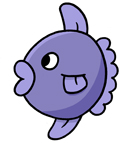 | The Japanese are quite fond of using the giant sunfish, or mola, as a generic "fish" symbol, even though these enormous, grotesque, deep sea-dwelling creature are hardly a common sight in Japan. |
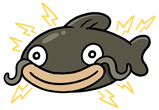 | This creature is known as the namazu (鯰), or electric catfish. Japanese folklore holds these guys responsible for creating natural disasters with their magic powers. |
 | A lucky cat (招き猫, literally "inviting cat") statue is one of the most common Japanese knickknacks, and a much-beloved good luck charm among small businessmen. The cat holds a koban coin (see below) and beckons customers with his paw. |
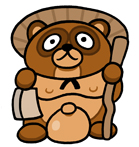 | Popularized by Super Mario Bros. 3 (1988), these guys are known as tanukis (狸), sometimes spelled "tanooki." Though the name is often clumsily translated into "raccoon-dog," which implies mixed-breeding, they're actually a unique fox-like species exclusive to Japan. They play an large role in Japanese folklore, usually as mischievous, shape-shifting tricksters. Small ceramic tanuki statues (ひねり狸) are often placed in bars or restaurants as a good luck charm. If you're eager to learn more about the tanuki myth, this site contains more information than you could possibly imagine. |
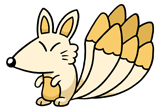 | Foxes, which are native to Japan, are common creatures in Japanese folklore, generally portrayed as magical beings with nihilistic personalities. Foxes supposedly grow more tails as they age, with a golden, nine-tailed fox, or kyuubi no kitsune (九尾の狐), being the most frighteningly powerful of all (nine is considered an ominous number in Japanese culture). Foxes are always depicted with squinty eyes, which is supposedly a sneaky or shifty expression. |
 | A Japanese octopus (蛸) is always colored red, and a Japanese squid (烏賊) is always colored white. This is because these are the colors the animals turn when you cook them — which is the form the Japanese are most familiar with. |
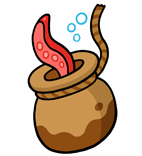 | The Japanese fish for octopuses with a device called a tako tsubo (蛸壺), which is a special type of ceramic jar tied to a rope. The octopus crawls into the jar, then the jar is yanked out of the water. Japanese octopuses are often depicted hanging in and around these things. |
 | Cartoon penguins are always blue. I assume for no reason other than it's a prettier color than black. |
 | The Japanese have a weirdly ingrained belief that birds, especially crows, like picking up rocks in their talons and dropping them on people. The rock-dropping-bird is a common animal stock character. |
 | Crabs in Japan are associated with blowing bubbles. Crabs actually do this in real life (well, they at least foam at the mouth occasionally) but for whatever reason, it is considered far more of an iconic “crab thing” in Japan than it is in the western world. |
 | Japan is home to enormous gross elephant beetles (甲虫), which Japanese kids like to capture and keep in terrariums, much to the horror of their mothers. Elephant beetles are a fairly common generic symbol for "bug," and bug-catching is a common Japanese trope. The entire premise of Pokémon is said to be inspired by beetle-catching. |
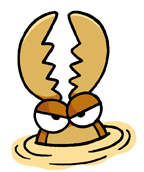 | Another popular type of Japanese bug is the antlion (or doodlebug), known in Japanese as a 蟻地獄, or literally "hell ant." They dig pits which they try to make other insects fall into. |
Cultural Artifacts
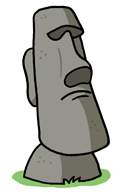 | The Japanese love to visit photogenic landmarks and are particularly fascinated by the art and statutes of ancient peoples (see below). This has given Chile’s Easter Island, or Rapa Nui, with its giant Polynesian head statues an outsized role in the Japanese imagination. In Japan, Easter Island is often portrayed alongside places like Paris and London as one of the world’s must-visit tourist destinations. In the 1990s, the Japanese government even donated millions to assist in repairing one of the island’s grandest statue formations, the Ahu Tongariki, that had been damaged in a 1960 earthquake. Japanese call the head statues moai (モアイ) which is their traditional Polynesian name. |
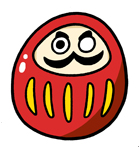 | These little red, round paper-mache things are called daruma dolls (達磨) modeled after a particularly obsessive 6th century Buddhist monk Bodhidharma, who cut off his eyelids so he wouldn’t fall asleep then meditated until all his limbs rotted off. This is considered an inspiring story of dedication to a cause, so Daruma dolls are a popular gift for people who are about to embark upon some sort of challenging adventure. You color in the second eye when you achieve your goal. |
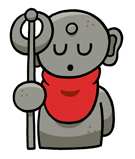 | Best known for their appearance as the “statute mode” of Mario’s tanooki suit, these are statutes of a buddhist saint, or Bosatsu (菩薩) known as jizo (地蔵). Jizo statutes are a common sight across Japan, and there is a tradition of knitting red bibs for them. In Buddhist tradition they serve as spiritual patrons for a bunch of different causes, particularly travelers and dead children. This site has an enormous amount of information on them. |
 | The period between the 4th to 6th century is known as Japan’s “tumulus era,” so named for the elaborate burial traditions of the time. The pre-Bhuddist Japanese decorated the tombs of their superiors with little clay sculptures known as haniwa (埴輪) to ensure afterlife companionship. These came in many different forms, but all had empty holes for the eyes and mouth. Though some were more recognizably humanoid, the most famous ones are little more than rounded lumps with sausage arms. |
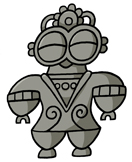 | During the stone age, Japan’s dominant cultural group was the Jomon, known for their distinctive pottery. Their best-known creations are doguu (土偶), or clay dolls, the most famous of which are the shakouki-doguu (遮光器土偶), which translates to something like “light-blocker goggle clay dolls,” so named because they appear to be wearing slitted eye coverings that were used for eye protection in neolithic times. The Japanese can be somewhat condescending when it comes to the art of ancient peoples, with the most popular stuff either being “cute” or possible to integrate into prehistoric alien visitation conspiracy theories. The roly-poly shakoukidoguu, who look kind of like spacemen from another planet, fit the bill nicely. |
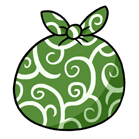 | Stereotypical Japanese thieves carry bags of loot made from green cloth with an distinctive vine pattern on it. It’s an ancient pattern that supposedly came to Japan via the Chinese, who got it from the Arab world, and as a result it’s known by a lot of different names. The Japanese call the design karakusa-moyou (唐草模様) which literally means something like “Chinese vine pattern,” while in English, it’s usually called an “arabesque” pattern, or “Japanese Ivy.” The cliché is that at one time, your typical Japanese household would have had a lot of tea towels and whatnot with this design, so a enterprising robber looking for something to carry all his stolen goods would steal a tablecloth to fashion a bindle. |
Other Objects
 | Popularized by the "Met" enemies in the Mega Man series, a correctly-depicted construction hard hat, known as a "safety helmet" (安全ヘルメット), will be a smooth yellow dome with a green stripe around the perimeter, interrupted by a single green cross in the front. Many Japanese hard hats actually look this way, even though the smoothness actually provides less structural strength than the corrugated western style. These days, most Japanese construction companies put their corporate logo where the green cross appears. The green cross itself is a generic Japanese symbol for safety in construction zones. |
 | Incidentally, the reason why construction themes tend to be prominent in many video games has to do with the complete and utter dominance of the construction industry in all aspects of Japanese life. Everything in Japan is always under construction, often as part of useless make-work projects spawned from corrupt deals between governments, unions, and mafiosos. If you're interested, I highly recommend a fine book called Dogs and Demons that delves into this in more detail. |
 | A kusudama (くす玉) is a giant paper ball stuffed with confetti and perhaps other crazy things that can be dramatically opened at the climax of a party. In English, "kusudama" is used as the name for a kind of origami paper ball, which is a different thing. |
 | This is what the Japanese call a cracker (クラッカー), which is a popular holiday party favor. You pull the string and confetti sprays out everywhere. |
 | Baby rattles always look like this: tall and cylindrical. |
 | Old-timey Japanese baby pacifiers (おしゃぶり) were quite different than the ones we use in the West, and resembled something closer to a wooden knob. Even though these aren't common anymore, the knob style remains the conventional depiction. |
 | During the modern period of Samurai rule known as the Tokugawa Shogunate (1603-1868), Japanese coins, known as Koban (小判), were these big oval-shaped gold discs with horizontal stripe indentations. Though they've long since been phased out, they remain a common symbol of wealth and cash. |
 | Coral (珊瑚), incidentally, is also often used as a symbol of wealth and cash, hearkening back to a time when Japanese people used to have slightly fewer reservations about hacking up the ocean to reap the treasures within. |
 | A Japanese snowman (雪だるま) will always be constructed from two balls, with a bucket for a hat, and eyes, mouth, eyebrows, and possibly nose made from children's building blocks. The limitations of using blocks as facial features usually ensures they'll have a pretty stern, vacant expression. |
 | The Japanese are quite fond of making snow rabbits (雪うさぎ) as well. These are just little lumps with nanten (南天) berries for eyes and berry leaves for ears. |
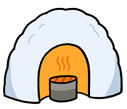 | An igloo, which the Japanese call a kamakura (かまくら). Building them, and cooking stew or mochi (see above) inside is a popular winter tradition in some of the country’s snowier regions, including the snowy region of Kamakura, of which they are named after. |
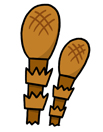 | What we in the West sometimes call "horsehair plants," "horsetails," or "scouring rush" are known in Japan as tsukushi (土筆) and are a common symbol of spring. Spotting the first tsukushi bud of the season is a common trope in Japanese culture. |
 | There’s a popular sort of megaphone (メガホン) in Japan that is just a simple plastic cone without any sort of electronics or handle. |
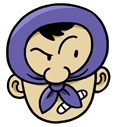 | Wearing a handkerchief tied under your nose is the Japanese cliche for someone trying to be sneaky — usually some kinda thief or robber — but in a very over-the-top, painfully incompetent, cornball kind of way. TV Tropes has more. |
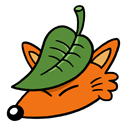 | In Japanese folklore, magical beasts like foxes and tanuki (see above) often rub their heads with leaves before transforming themselves into some other form. They’re shape-shifters, see. |
 | Japanese depictions of UFO's (ユーフォー, or simply "UFO," written in English letters) tend be stuck in the 1950s, when flying saucers were often depicted as lamp-shaped, with light bulb-like protrusions at the bottom. Likely this was because one of the leading ufologists of the time, George Adamski (1891-1965) circulated alleged UFO photos that were almost certainly just photos of lamps in his office. The YouTuber Nick Robinson has done a full video about this. |
Symbols
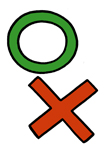 | When you do something wrong in Japan, they use an "X" to indicate the mistake, just like us in the West. But when you do something right, instead of a western-style check mark, they use an "O." |
 | The swastika was of course a perfectly innocent symbol before the Nazis came along, and was present to some extent in basically all cultures of the world prior to Hitler. The Japanese call it a manji and use the swastika as its kanji character — 卍. Despite Japan’s failed alliance with Germany during World War II, which you might expect to create a bit of sensitivity around the thing, the swastika is still a relatively non-taboo symbol in Japan, associated with with Buddhism and good luck. |
 | The English letter W is often used a shorthand for “double” in Japan. Because it’s a “double-u,” get it? Clyde Mandelin has a thorough explanation of this on his wonderful Legends of Localization website. |
 | In Japan, the color purple is stereotyped as being a "bad" color, often associated with villains and poison. It's very unlikely anything intended to be positive or good for you will be colored purple. |
Monsters and Ghosts
Japanese culture can be quite dark at times, and has a particularly marked fascination for all things involving death and the supernatural. I remember when I worked as a Japanese ESL teacher, we had this sheet of sample “conversation starter” questions to use with our adult students, and right up there with “Do you have any children?” and “What kind of work do you do?” was “Do you believe in ghosts?” Of course, these days the contemporary Japanese Cult of Cute has turned a lot of the country’s traditional monsters and goblins into these very tame, cuddly things, which is probably the form most westerners are most familiar with. In any case, these are some of the common Japanese monster faces, in games and elsewhere:
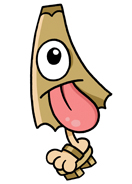 | Perhaps the most commonly seen Japanese monster, the Kasa Obake (唐傘おばけ), or literally "umbrella monster", is roughly equivalent to the American "white sheet ghost" as a generic symbol of something scary. The Japanese have this whole ancient superstition that if you mistreat your possessions in life, they'll come back to haunt you someday in the form of monsters known as tsukumogami (付喪神). Though you'll see monster depictions of all sorts of inanimate objects, the umbrella one remains the most cliched and ubiquitous. |
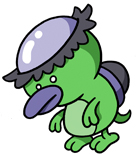 | These guys, kappas (河童), are actually supposed to be quite horrifying, though their colloquial mythology has softened somewhat in recent years. They're these lizard-type things that hang out by the riverbed, and if you come too close they'll pull you in and rape and murder you. This, I understand, was a story dreamed up by Japanese parents to keep their kids from hanging out near the dangerous water. Kappas are missing the top part of their skull, so to keep their brain juices from leaking out and killing them, they usually wear little plates on their heads. They also like the taste of cucumbers (it reminds them of human flesh), which is why the Japanese call cucumber sushi "kappa rolls." |
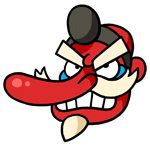 | A tengu (天狗) is a red-faced creature with a long nose who lives in the mountains. They sometimes wave palm leaves to creature hurricanes and are notorious for their arrogance. |
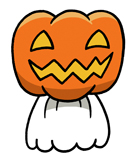 | The Japanese usually refer to a jack-o-lantern with the English word “pumpkin” (パンプキン). A popular stock Halloween character in Japan is a jack-o-lantern with a ghost body or cape. |
 | A generic Japanese alien, or kaseijin (火星人, literally “Mars person”), is usually depicted as a sort of jellyfish thing. A traditional "American style" alien is called a "Grey" (グレイ). |
 | Many centuries ago, it used to be part of the traditional Japanese burial costume to wear a little cloth triangle on your head. This isn't done anymore, but the triangle hat remains a common symbol of death just the same, and is often an accessory found on stereotypical depictions of humanoid ghosts or zombies (particularly sexy female ones). It is sometimes called a hitaikakushi (額隠). |
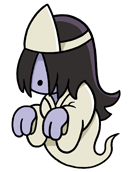 | Speaking of sexy lady ghosts, those play a big role in Japanese lore as well. Known as yurei (幽霊), they're supposed to represent the victims of tragedies, such as suicides or murders, which gives them a kind of gothic, melodramatic quality. |
 | A hito-dama (人魂) is a creepy floating fireball, supposedly containing a human soul. I guess these are the spirits of people who couldn't come back as one of the more interesting-looking ghosts. They tend to show up wherever other scary things are found. |
